Transcription of STRATEGY, STRATEGIC MANAGEMENT, STRATEGIC …
1 2016 strategy , STRATEGIC management , STRATEGIC PLANNING AND STRATEGIC THINKING Fred Nickols strategy , STRATEGIC PLANNING, STRATEGIC THINKING, STRATEGIC management Fred Nickols 2016 Page 1 IN T R O D U C T I O N This paper was first written when I was head of STRATEGIC Planning & Manage-ment Services at Educational Testing Service (ETS). It examines the words and terms making up its title and presents them in a way intended to make them useful tools for those charged with related duties. ST R A T E G Y strategy is a word with many meanings and all of them are relevant and useful to those who are charged with setting strategy for their corporations, business-es, or organizations. Some definitions of strategy as offered by various writers spanning the years 1962 to 1996 are briefly reviewed below.
2 Alfred D. Chandler, Jr., author of strategy and Structure (1962), the classic study of the relationship between an organization s structure and its strategy , defined strategy as the determination of the basic long-term goals and objectives of an enterprise, and the adoption of courses of action and the allocation of resources for carrying out these goals. (As we will see later, it is the allocation of re-sources that ties the civilian use of strategy to its military origins.) Robert N. Anthony, author of Planning and Control Systems (1965), one of the books that laid the foundation for STRATEGIC planning, didn t give his own defini-tion of strategy . Instead, he used one presented in an unpublished paper by Harvard colleague Kenneth R. Andrews: the pattern of objectives, purposes or goals and major policies and plans for achieving these goals stated in such a way as to define what business the company is or is to be in and the kind of company it is or is to be.
3 (Here we can see the emergence of some vision of the compa-ny in the future as an element in strategy .) Kenneth Andrews, long-time Harvard professor and editor of the Harvard Busi-ness Review, published the first edition of The Concept of Corporate strategy in 1971 and updated it in 1980. His published definition of strategy took this form in the 1980 edition: the pattern of decisions in a company that determines and reveals its objectives, purposes or goals, produces the principal policies and plans for achieving those goals, and defines the range of businesses the compa-ny is to pursue, the kind of economic and human organization it is or intends to be, and the nature of the economic and non-economic contribution it intends to strategy , STRATEGIC PLANNING, STRATEGIC THINKING, STRATEGIC management Fred Nickols 2016 Page 2 make to its shareholders, employees, customers, and communities.
4 (Andrews definition of strategy is rather all-encompassing and is perhaps best viewed as a variation on the military notion of grand strategy .) George Steiner, a co-founder of the California management Review, and author of the 1979 bible, STRATEGIC Planning: What Every Manager Must Know, ob-served that there was little agreement on terms or definitions and confined his discussion of the definition of strategy to a lengthy footnote. But, nowhere does he define strategy in straightforward terms. Michael Porter, another Harvard professor, became well known with the publi-cation of his 1980 book, Competitive strategy . Porter defined competitive strategy as a broad formula for how a business is going to compete, what its goals should be, and what policies will be needed to carry out those goals.
5 (In contrast with Andrews definition, Porter s is much narrower, focusing as it does on the basis of competition.) Also published in 1980, was Top management strategy , by Benjamin B. Tregoe (of Kepner-Tregoe fame), and John W. Zimmerman, a long-time associate of Tregoe s. They defined strategy as the framework which guides those choices that determine the nature and direction of an organization. (This definition is quite succinct but still includes nature and direction. ) In 1994, Henry Mintzberg, an iconoclastic professor of management at McGill University, took the entire STRATEGIC planning establishment to task in his book, The Rise and Fall of STRATEGIC Planning. In effect, Mintzberg declared strategy did indeed have several meanings, all of which were useful.
6 He indicated that strategy is a plan, a pattern, a position, a perspective and, in a footnote, he indi-cated that it can also be a ploy, a maneuver intended to outwit a competitor. A more recent entry appears in STRATEGIC Planning for Public and Nonprofit Or-ganizations, published in 1996 by John Bryson, professor of planning and public policy at the University of Minnesota. Bryson defines strategy as a pattern of purposes, policies, programs, actions, decisions, or resource allocations that de-fine what an organization is, what it does, and why it does it. strategy , STRATEGIC PLANNING, STRATEGIC THINKING, STRATEGIC management Fred Nickols 2016 Page 3 In the military, the strategy for a battle refers to a general plan of attack or de-fense. Typically, this involves arrangements made before actually engaging the enemy and intended to disadvantage that enemy.
7 In this context, strategy is concerned with the deployment of resources. In civilian terms, this amounts to the allocation of resources. Tactics is the companion term and it refers to ac-tions formulated and executed after the enemy has been engaged in the heat of battle, as it were. Tactics, then, is concerned with the employment of resources already deployed. In the civilian sector, this equates to operations in the broad sense of that term. Generally speaking, tactical maneuvers are ex-pected to occur in the context of strategy so as to ensure the attainment of stra-tegic intent. However, strategy can fail and, when it does, tactics dominate the action. Execution becomes strategy . Thus it is that, whether on the battlefield or in business, the realized strategy is always one part intended (the plan as conceived beforehand) and one part emergent (an adaptation to the conditions encountered).
8 As a consequence, there are always two versions of a given strategy : (1) strategy as contemplated or intended and (2) strategy as realized. Although there are many similarities in the definitions above, there are also some important differences. We are left, then, with no clear-cut, widely-accepted definition of strategy ; only different views and opinions offered by dif-ferent writers working different agendas. We come now to a definition of strategy that I proposed for use when I was head of STRATEGIC Planning and management Services at Educational Testing Service: strategy refers to a general plan of action for achieving one s goals and objectives. A strategy or general plan of action might be formulated for broad, long-term, corporate goals and objectives, for more specific business unit goals and objec-tives, or for a functional unit, even one as small as a cost center.
9 Such goals might or might not address the nature of the organization, its culture, the kind of company its leadership wants it to be, the markets it will or won t enter, the basis on which it will compete, or any other attribute, quality or characteristic of the organization. As my definition implies, it is my view that strategy (and tac-tics) relate to how a given end is to be attained. Together, strategy and tactics strategy , STRATEGIC PLANNING, STRATEGIC THINKING, STRATEGIC management Fred Nickols 2016 Page 4 bridge the gap between ends and means. Resources are allocated or deployed and then employed in the course of executing a given strategy so as to realize the end in view. The establishment of the ends to be attained does indeed call for STRATEGIC thinking, but it is separate from settling on the strategy that will re-alize them.
10 Before coming to grips with the term STRATEGIC planning, it is best to examine each of those terms separately. Let s tackle STRATEGIC first. ST R A T E G I C Surprisingly, here there is ready agreement. But again there are different nu-ances. Clearly, STRATEGIC means of or having to do with strategy . Because strategies can and do exist at various levels of the organization, it is entirely conceivable and appropriate for the corporation to have a STRATEGIC plan, for a business unit to have one too, and for a functional unit to have one. STRATEGIC also means of great significance or import and so STRATEGIC plans, at all levels, are intended to address matters of great importance. For those concerned with the enterprise, STRATEGIC issues, initiatives, and plans are those that affect the entire enterprise in important ways.












